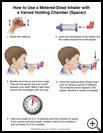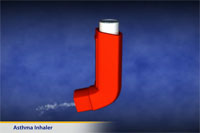
Metered-Dose Inhaler, How to Use with a Spacer
What is a metered-dose inhaler with a spacer?
A metered-dose inhaler is a pressurized container that releases a mist of medicine. Your child inhales the medicine into the airways of the lungs.
A device called a spacer can be used with the inhaler. Examples of spacers are the AeroChamber or the OptiChamber. The spacer helps make sure the inhaler is at the correct distance from your child's mouth and at the best angle. Your child can more easily breathe in the medicine, and not worry about coordinating the timing. The spacer can be used with or without a mask.
Metered dose inhalers contain a gas that helps the medicine get into your child’s lungs. Inhalers used to contain CFC (chlorofluorocarbon) gas, which is harmful to the environment. A different gas is now used in inhalers. The spray comes out with less force, is warmer, and has a slightly different taste than the CFS gas. Your child won’t feel it as much in the throat when he inhales the medicine, but your child still gets the right amount of medicine.
How do I use the inhaler with a spacer?
Before the first use, wash the spacer with warm soapy water. Do not rinse. Allow to air dry.
To attach the inhaler to the spacer:
- Remove the caps from the spacer and metered-dose inhaler.
- Shake the inhaler vigorously.
- If the inhaler has not been used before or if the inhaler has not been used for a while, you must then “prime” the inhaler. Do this by spraying 2 or 3 sprays of the medicine into the air. Each time you use the inhaler, the next dose is drawn into a chamber inside the inhaler. If the inhaler has not been used or sits for a long time without being used, some of the medicine leaks out of the holding area. This means your child will not get the full dose of medicine the next time it is used. Priming the inhaler makes sure that your child gets the full dose of the medicine.
- Insert the mouthpiece of the inhaler into the rubber-sealed end of the spacer.
To use the inhaler with the spacer and mask:
- Select the correct size mask for the patient (small, medium, or large) and attach to the mouthpiece end.
- Have your child stand or sit up straight.
- Put the mask to your child's face, covering both the nose and mouth. The mask must be pressed to your child's face to assure that the medicine can get to the child's lungs.
- Depress the inhaler once.
- Have your child breathe in and out slowly through the spacer for at least 5 breaths.
- When additional puffs are prescribed by your healthcare provider, wait 1 minute and repeat.
To use the inhaler with the spacer and mouthpiece:
- Have your child stand or sit up straight.
- Place the chamber into your child's mouth. Ask your child to breathe slowly in and out of the spacer several times.
- Depress the inhaler once.
- Have your child breathe in as deeply as possible and then hold his breath for 10 seconds. For children unable to hold their breath, another method is to breathe in and out slowly for 3 to 5 breaths.
- When your provider prescribes additional puffs, wait 1 minute and repeat.
Tracking Doses
How to track doses for scheduled medicine used every day:
- Place a blank label around the boot of the inhaler.
- Identify the number of puffs (actuations) available by reading the label on the inhaler canister.
- Divide the number of available puffs by the prescribed number of puffs per day. (For example, 120 doses available divided by 4 puffs per day would equal a 30 day supply of doses.)
- Write the date on the label that you will need to refill the prescription. Allow a 5 day grace period. (For example if you started on 7/1, show a date 25 days later (30 day supply minus 5 days).
How track doses for medicine used as needed:
- Place a blank label around the boot of the inhaler.
- Identify the number of puffs (actuations) available by reading the label on the inhaler canister.
- Write down the start date and number of puffs available on the label.
- Make a hash mark for each puff used (include wasted puffs).
- Get a refill when 10 puffs are left.
How do I clean the inhaler and spacer?
Wash the spacer and the plastic case for the inhaler once a week with soapy tap water. Rinse well and let the parts air dry.
Replace the one-way valve or get a new spacer when the valve dries out and starts to curl.
Last modified: 2011-09-09
Last reviewed: 2010-12-13


